News
Article
PI-RADS update does not improve Gleason grade discordance between MRI-targeted biopsy and radical prostatectomy
Author(s):
“Implementation of the most recent PI-RADS update did not improve the incongruence in prostate cancer grade assessment between MRI/ultrasound fusion targeted biopsy and surgery,” the authors wrote.
Study results published in the American Journal of Roentgenology indicate that magnetic resonance imaging (MRI) grading assessment of prostate cancer with PI-RADS 2.1 is not significantly different than utilizing PI-RADS 2.0.1
The authors found a 22% upgrade rate and a 10% clinically significant upgrade rate with PI-RADS 2.1 versus 29% and 14%, respectively, with PI-RADS 2.0. For patients in the PI-RADS 2.1 cohort, the downgrade rate was 21% in comparison to 19% with PI-RADS 2.0. Both cohorts had a clinically significant downgrade rate of 1%.

For the retrospective study, recently published in the American Journal of Roentgenology, researchers reviewed data from 308 patients who had 3T prostate MRI, subsequent MRI/ultrasound fusion targeted biopsy (Tbx) and a radical prostatectomy within one year. The study authors compared the use of PI-RADS 2.1 for 131 patients versus PI-RADS 2.0 in 177 patients to assess the impact of the updated PI-RADS classification on the grading of prostate cancer (PCa).
The authors found a 22% upgrade rate and a 10% clinically significant upgrade rate with PI-RADS 2.1 versus 29% and 14%, respectively, with PI-RADS 2.0. For patients in the PI-RADS 2.1 cohort, the downgrade rate was 21% in comparison to 19% with PI-RADS 2.0. Both cohorts had a clinically significant downgrade rate of 1%.
In other words, the study authors found no significant differences between PI-RADS 2.1 and PI-RADS 2.0 in MRI grading of PCa.
“Implementation of the most recent PI-RADS update did not improve the incongruence in PCa grade assessment between Tbx and surgery,” wrote study co-author Baris Turkbey, M.D., a senior clinician and radiologist at the National Cancer Institute and the National Institutes of Health in Rockville, Md., and colleagues.
The researchers saw similar concordance rates between Tbx and radical prostatectomy for both cohorts (57% for PI-RADS 2.1 vs. 51% for PI-RADS 2.0). Turkbey and colleagues also noted similar concordance rates in grade group 2 (GG2) patients and GG3 patients (57% for PI-RADS 2.1 vs. 53% for PI-RADS 2.0).
Turkbey and colleagues emphasized the importance of being able to distinguish between GG2 and GG3 in cases of clinically significant prostate cancer (csPCa).
“ … The presence of GG3 may change the patient’s risk category from favorable intermediate risk to unfavorable intermediate risk per (National Comprehensive Cancer Network (NCCN) guidelines,” noted Turkbey and colleagues. “In patients with favorable intermediate risk, active surveillance may remain a management option; however, unfavorable intermediate risk usually requires active treatment with surgical intervention or radiotherapy.”
In regard to study limitations, the researchers conceded that review of all MRI images in the study by one genitourinary radiologist and a small number of patients with PI-RADS categories 2 or 3 may limit broader extrapolation of the study findings. The study authors also acknowledged possible selection bias with the cohort being limited to patients who underwent radical prostatectomy.
Reference
1. Yilmaz EC, Lin Y, Belue MJ, et al. PI-RADS Version 2.0 Versus Version 2.1: Comparison of Prostate Cancer Gleason Grade Upgrade and Downgrade Rates From MRI-Targeted Biopsy to Radical Prostatectomy [published online ahead of print September 20, 2023].
AJR Am J Roentgenol. doi: 10.2214/AJR.23.29964


